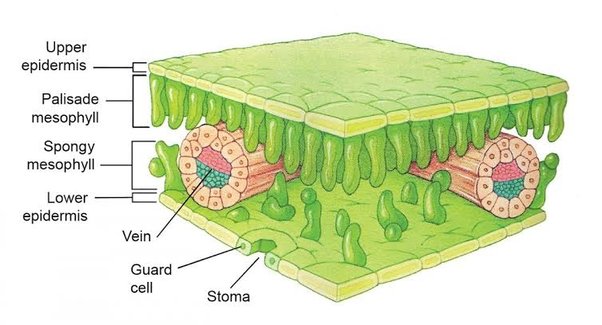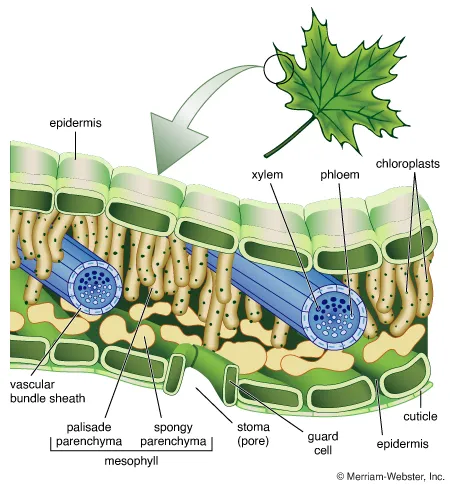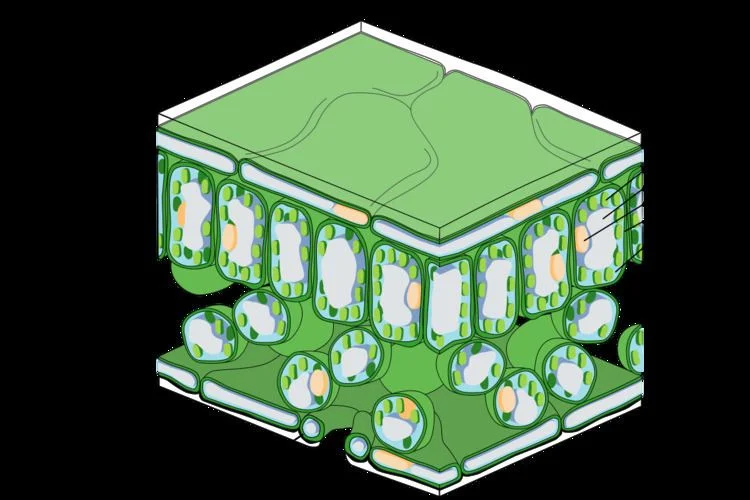A palisade cell, a fundamental component of a leaf’s mesophyll, exhibits extraordinary adaptations tailored to its pivotal role in photosynthesis. These adaptations include an elongated shape, maximizing the cell’s exposure to sunlight.
The strategic placement of chloroplasts, the cellular organelles responsible for converting light energy into chemical energy, further enhances light absorption. The upper positioning of palisade cells within the leaf allows them to efficiently capture sunlight, thanks to an abundance of chlorophyll-containing chloroplasts.
Stomata facilitate gas exchange, ensuring a balance between carbon dioxide uptake and oxygen release. Additionally, vascular tissues and plasmodesmata enable nutrient transport and resource sharing among palisade cells.
These intricate adaptations collectively empower palisade cells to excel in their role as photosynthetic factories, sustaining plant life through the conversion of light into essential energy.
Where Are The Palisade Mesophyll Cells Located?

The location of palisade mesophyll cells in the upper layer of plant leaves is a strategically engineered feature of plant anatomy. This positioning is vital for their role in photosynthesis, the fundamental process by which plants convert light energy into chemical energy, ultimately producing food and oxygen.
By being situated near the leaf’s upper surface, these cells are optimally exposed to sunlight, which is essential for photosynthesis. This placement ensures that they receive a maximal amount of light, which is crucial for the efficient functioning of chloroplasts contained within these cells.
Chloroplasts are the cellular organelles responsible for capturing and converting light energy into chemical energy through the pigment chlorophyll. The upper leaf position of palisade mesophyll cells helps minimize self-shading, allowing them to harness the available sunlight to its fullest extent.
The lower layer of the leaf, known as the spongy mesophyll, collaborates with the palisade mesophyll cells to support gas exchange, regulating the uptake of carbon dioxide and release of oxygen. This partnership between the two layers ensures a balance between photosynthesis and the minimization of water loss.
In summary, the strategic location of palisade mesophyll cells in the upper layer of leaves showcases nature’s precision in adaptation. Their position optimizes light absorption and supports the plant’s vital function of photosynthesis, ultimately sustaining plant life and influencing the planet’s oxygen and food production.
Why Are Palisade Cells Adapted for Photosynthesis?
Palisade cells are specifically adapted for photosynthesis, a fundamental process in plants, due to the following reasons
Position in Leaf Tissues
Palisade cells are strategically located in the upper layer of leaves. This positioning ensures that they are exposed to the maximum amount of sunlight, which is essential for photosynthesis. By being near the leaf’s surface, they can efficiently capture and utilize sunlight for this process.
Large Surface Area
These cells have an elongated, columnar shape, which maximizes their surface area. A larger surface area means that they can capture more sunlight and perform more photosynthesis. This adaptation allows them to be highly efficient in converting light energy into chemical energy.
Numerous Chloroplasts
Chloroplasts are the organelles within palisade cells responsible for photosynthesis. Palisade cells have a high concentration of chloroplasts near the cell’s surface. This concentration ensures that they can absorb as much light as possible. Chloroplasts contain chlorophyll, the pigment that captures light energy and converts it into chemical energy.
Gas Exchange
While photosynthesis involves capturing light energy, it also requires the exchange of gases, primarily the uptake of carbon dioxide and the release of oxygen. Palisade cells have small openings called stomata that allow for the exchange of gases. This adaptation ensures that they have access to the carbon dioxide needed for photosynthesis and can release oxygen, a byproduct of the process.
Environmental Adaptations
Palisade cells can adapt to various environmental conditions. In high-light environments, they may have more chloroplasts to capture extra sunlight. In low-light conditions, they may elongate to reach closer to the available light source. These adaptations help them make the most of their surroundings.
How Do Palisade Cells Maximize Light Absorption?
Palisade cells maximize light absorption through several structural and organizational adaptations
Position in Leaf Tissues
Palisade cells are typically located in the upper layers of plant leaves. This strategic positioning places them closer to the source of light, ensuring they receive the maximum amount of sunlight available. Sunlight is the essential source of energy for photosynthesis, and by being in the upper epidermis, palisade cells capture light efficiently.
Elongated Shape
Palisade cells have an elongated, columnar shape. This elongation increases the surface area of the cell that is exposed to light. A larger surface area means that there is more cell membrane available for capturing light. This adaptation allows them to absorb a greater amount of light energy.
Chloroplast Distribution
Chloroplasts, the organelles responsible for photosynthesis, are densely packed in palisade cells. These chloroplasts contain the pigment chlorophyll, which captures light energy and converts it into chemical energy. The high concentration of chloroplasts near the cell’s surface ensures that they are well-exposed to light and can efficiently capture and utilize it for photosynthesis.
Minimal Light Blockage
Palisade cells are positioned closely together, and they have a minimal intercellular space. This arrangement reduces the chance of light being blocked or scattered by other cells, as it can easily penetrate the upper leaf layers and reach the palisade cells. This minimizes the loss of incoming light.
Vertical Arrangement
The elongated shape of palisade cells allows them to be stacked vertically within the leaf. This vertical arrangement further reduces the distance that light needs to travel through the cell layers to reach the chloroplasts. This means that even more of the incident light can be absorbed by the cells.
How Do Palisade Cells Regulate Gas Exchange for Photosynthesis?

Palisade cells play a crucial role in regulating gas exchange for photosynthesis through specialized adaptations
Stomata: Stomata are small openings found on the surface of leaves, including the epidermis where palisade cells are located. These tiny pores act as gateways for gas exchange. They allow for the uptake of carbon dioxide (CO2), which is essential for photosynthesis, and the release of oxygen (O2), a byproduct of the process.
Controlled Opening: Palisade cells are surrounded by stomata, and these cells have the ability to regulate the opening and closing of these pores. The opening and closing of stomata are primarily controlled by the turgor pressure of the guard cells, which flank the stomata. When the guard cells become turgid (filled with water), the stomata open, allowing for the exchange of gases. When the guard cells lose water and become flaccid, the stomata close.
Timing: The opening and closing of stomata are carefully timed to optimize the process of photosynthesis. Stomata typically open during the day when there is light for photosynthesis and close at night. This prevents excessive water loss through transpiration when photosynthesis is not occurring.
Adaptations to Reduce Water Loss: While the primary function of stomata is to allow gas exchange, they also have adaptations to reduce water loss. Some plants have specialized structures like trichomes (hair-like structures) that can help trap moisture and reduce transpiration.
Adaptation to Environmental Conditions: Palisade cells and their associated stomata can adapt to various environmental conditions. In high-light environments, when photosynthesis is most active, stomata may open wider to allow for increased CO2 uptake. In contrast, in low-light conditions or when water availability is limited, stomata may partially or completely close to reduce water loss and prevent wilting.
FAQ
How is a stem cell adapted to its function?
Stem cells are unique due to their remarkable adaptability. They can self-renew and differentiate into specialized cell types, serving as the building blocks of various tissues and organs. Their capacity to divide and differentiate allows them to repair and regenerate damaged tissues in the body.
What are the 4 functions of plant cells?
Plant cells perform key functions, including photosynthesis (chloroplasts capture sunlight), storage (central vacuole holds nutrients), structural support (cell wall maintains shape), and growth (cell division and expansion).
What are the six 6 main functions of a cell to live?
The primary functions of a cell are to carry out metabolism (energy production and use), maintain homeostasis (internal balance), respond to stimuli, reproduce, grow and develop, and carry genetic information.
What are the characteristics and functions of a plant cell?
Plant cells have unique characteristics, including a cell wall, chloroplasts, and a large central vacuole. These features enable them to photosynthesize, provide structural support, and store nutrients effectively.
What are the parts of a plant cell and their functions?
Plant cell parts and functions include the cell wall (provides support), chloroplasts (photosynthesis), central vacuole (storage and turgor pressure), nucleus (genetic control), and more specialized structures like mitochondria (energy production) and endoplasmic reticulum (protein synthesis).
What is plant cell class 7?
In a Class 7 science curriculum, students typically learn about plant cell structure, including its parts and functions. This knowledge forms the basis for understanding plant biology.
What is the main function of the cell membrane in a plant cell?
The cell membrane (plasma membrane) in a plant cell acts as a selective barrier, regulating the passage of substances in and out of the cell. It is crucial for maintaining cell integrity, osmotic balance, and protecting the cell’s internal environment.
What is the main function of the cell wall in a plant cell?
The cell wall in a plant cell provides structural support, protection, and shape to the cell. It acts like a rigid exoskeleton, allowing the cell to withstand osmotic pressure and environmental stresses while preventing overexpansion.
Final words
In the fascinating realm of plant biology, palisade cells stand as remarkable examples of adaptation. Their intricate structural and functional features are nothing short of awe-inspiring. These cells, perched in the upper layers of leaves, are superbly adapted for the crucial role of photosynthesis.
Their adaptations, such as strategic chloroplast distribution, a high surface area, and gas exchange regulation, reveal nature’s precision in engineering cells to optimize the capture of sunlight, efficient gas exchange, and nutrient transport.
In a world where energy and resources are paramount, palisade cells showcase how nature has fine-tuned its designs to ensure the success of photosynthesis, the lifeblood of plant existence. The adaptations of palisade cells are a testament to the beauty and complexity of the natural world, a reminder that every leaf holds within it a masterpiece of adaptation.

